Table of Contents
Kinesiology Tape or Kinesiotape
* Relieves pain and muscle fatigue
* Ameliorate circulation and lymphatic flow via superficial activation while decreasing inflammation
* Corrects muscle function through decrease of muscle tension and strengthening of the weakened muscle
* Corrects misalignment of joints
* Returns body to homeostasis.
* Works with the body to allow and increase normal range of motion
* May normalize length/tension ratios to optimize force
* Assist and ameliorate tissue recovery
* Gives back epidermal tissue homeostasis
* Reduce inflammation and pressure on mechanical receptors
Contusion / bruise
You will need:
1 strip of I-kinesiotape
Self Taping is possible
Step 1 : Apply the I-shaped sport tape on the bruise’s spot. The sport tape should be stretched in the center at 70 to 80% and no stretch at the sides.
Step 2 : For additional assistance you can apply a second sport tape (overlapping) in the same way through the first.
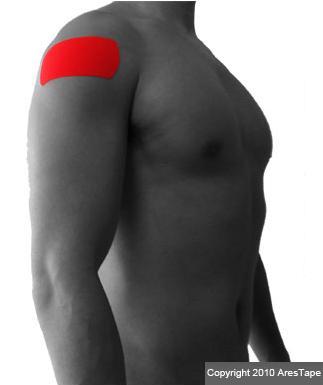
Contusions/bruises happen when a direct blow or repeated blows from an object hit a part of the body, crushing underneath muscle fibers and connective tissue without destroying the skin. A bruise can be the result of falling or jamming the body against a hard surface.
Sometimes a pool of blood accumulates within damaged tissue, and forms a lump over the contusion (hematoma). In severe cases, swelling and bleeding under the skin may have shock consequences. If tissue damage is extensive, you might also have a broken bone, dislocated joint, sprain, torn muscle, or another type of injuries.
Bruises cause swelling and pain and limit joint range of motion near the injury. Torn blood vessels might be responsible for bluish discoloration. The harmed muscle may feel weak and stiff.
To manage pain, bleeding, and inflammation, put the muscle in a soft stretch position and use the RICE formula:
* Rest: Protect the injured spot from further harm by stopping activity. You may also use a protection (i.e., crutches, sling).
* Ice: Apply ice wrapped in a clean tissue. (Remove ice after 20 minutes.)
* Compression: Lightly wrap the harmed spot in a soft bandage or ace wrap.
* Elevation: Raise it to a level above the heart.
For the first two days after injury (acute phase), you will probably have to continue using rest, ice, compression bandages, and elevation of the injured area to control bleeding, swelling, and pain. During the healing of the injured part, be sure to keep training the uninjured parts of your body to keep your overall fitness levelled.
Afterwards, inflammation should start to go down and the contusion might feel a little bit better.
Indigestion
You will need:
2 Pieces of I-Shaped Kinesiotape
Self Taping is possible
Step 1 :
Stick the I-Shaped kinesiotape on the center of the stomach just above the belly button, with a soft stretch on the middle and no stretch on the sides.
Step 2 : Stick another I-shaped kinesiotape perpendicularly to the first kinesiotape with the same stretch application than the first.
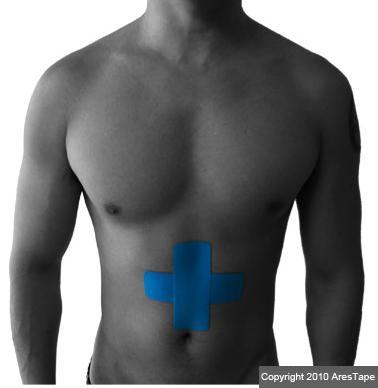
Indigestion is very common within adults and can happen once in a while and any day.
Indigestion can be caused by a disease in the digestive tract such as gastroesophageal reflux disease (GERD), peptic ulcer disease, cancer, or unusual condition of the pancreas or bile ducts.
People suffering of indigestion present at least one of the following symptoms:
* Fullness during a meal. The person feels to have eaten too much or that she/he cannot finish the meal.
* Bothersome fullness after a meal. The person might have the sensation that the food is staying in the stomach too long.
* Epigastric pain. The epigastric area is between the lower end of the chest bone and the navel. The person may have epigastric pain ranging from mild to severe.
* Epigastric burning. The person feels a very uncomfortable sensation of heat in the epigastric area.
Frozen Shoulder
You will need:
4 Y-shaped kinesiotaping strips
1 I-shaped kinesiotaping strip
Self taping is possible
Step 1 : Stick a Y shaped kinesiotaping strip on the side of the shoulder until the back part of the shoulder as shown on the figure.
Step 2 : Apply another Y shaped sport tape on the upper arm and stick the lateral wing to the upper part of the shoulder while holding the arm lifted forward to stretch the posterior part of the shoulder.
Step 3 : Stick the front wing of the Y shaped kinesiotape to the top of the shoulder while holding the arm behind the back, to stretch the anterior part of the shoulder.
Step 4 : Apply another Y shaped sport tape on the back of the superior part of the shoulder, starting from the spine.
Step 5 : Stick another Y shaped sport tape on the front part of the shoulder towards the chest.
Step 6 : Finally add another I shaped kinesiotaping strip on the shoulder joint, in a vertical position starting from the upper arm.
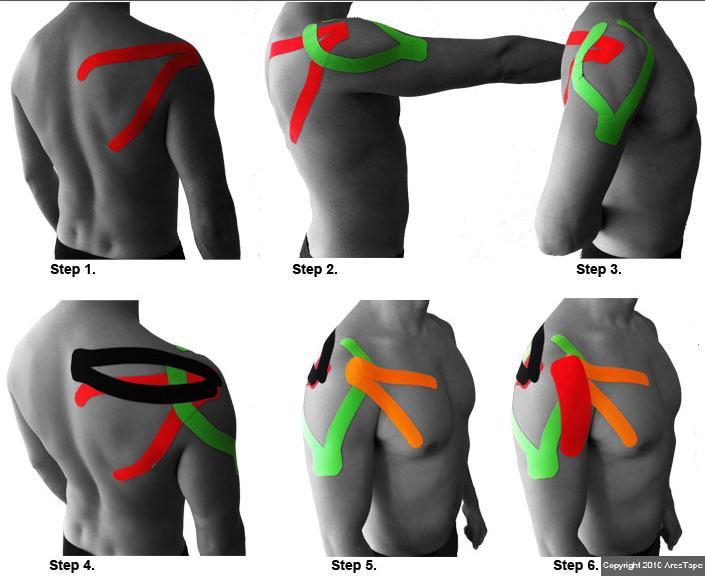
The origins of the frozen shoulder are not entirely determined. The process involves thickening and contracture of the capsule around the shoulder joint.
Frozen shoulder happens commonly in individuals suffering from diabetes, affecting 10 to 20% of these individuals. Other associated medical issues with augmented risk of frozen shoulder include: hypothyroidism, hyperthyroidism, Parkinson’s disease, and cardiac disease or surgery.
Frozen shoulder can appear after the immobilization of the shoulder for a certain amount of time. Attempts to prevent frozen shoulder include early motion of the shoulder after it has been injured.
Symptoms
– Sensation due to frozen shoulder is usually dull or painful. It can be worsened with attempted motion. The pain is normally located over the outer shoulder area and less frequently on the upper arm.
– The characteristic of the disease is restricted motion or stiffness in the shoulder. The affected individual cannot move the shoulder properly. Motion is also limited when someone else attempts to move the patient’s shoulder.
Treatment
Frozen shoulder will usually recover itself. However, this takes a while, occasionally up to two to three years. Treatment is aimed at pain control and restoring motion.
Shoulder Pain from Overuse
You will need:
2 Y shaped kinesiotaping strips
A partner too apply the kinesiotaping strips
Step 1 : Apply the first Y kinesiotape to the front part of the shoulder and stick the wings on the chest while holding the arm against the back.
Step 2: Apply the second Y sport tape on the front shoulder and fix the wings on the inner side of the elbow while bending the elbow a little bit.
Step 3: No stretched applied
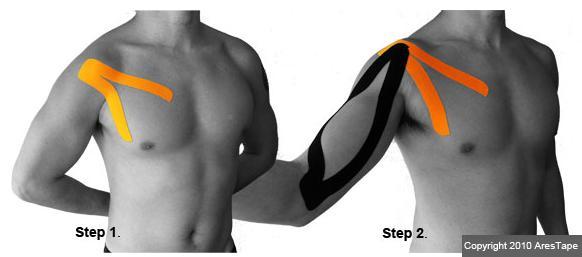
What people call “the shoulder” is in fact several joints combining tendons and muscles which allows a wide range of movements to the arm, from the scratching of your back to the throwing of a little rock. However movement has a price. It might increase problems with instability or troubles of soft tissue resulting in pain. Feeling pain may only happen when the shoulder is moved, or all of the time. The pain may be temporary and vanish after a small period of time, or it may keep on going and thus require medical diagnosis and treatment.
Cause
Most shoulder problems involve the soft tissues, muscles, ligaments, and tendons, rather than bones. And most problems fall can be divided in three main types:
* tendinitis/bursitis
* injury/instability
* arthritis
Treatment
Treatment generally requires altering activities, rest and physical therapy to help you improve shoulder strength and flexibility.
Surgery may be required to resolve shoulder problems; however, 90 percent of patients with shoulder pain will follow simple healing methods such as altering activities, rest, exercise and medication.
Common sense solutions such as avoiding overexertion or overdoing activities which are not part of your daily basis can help you to prevent shoulder problems.
Intercostals’ Neuralgia
You will need:
4 long Y-Shaped kinesiotaping strips and a partner for the application
Step 1 : Apply the base of the two Y-Shaped sport tapes on the side of the rib cage, starting from the belly, and stick the wings towards the back, as described on the picture, while lifting the arms up.
Step 2 : Apply the base of the two Y-Shaped sport tapes on the side of the rib cage, starting from the back, towards the chest while lifting the arms.
Step 3 : No stretch applied.
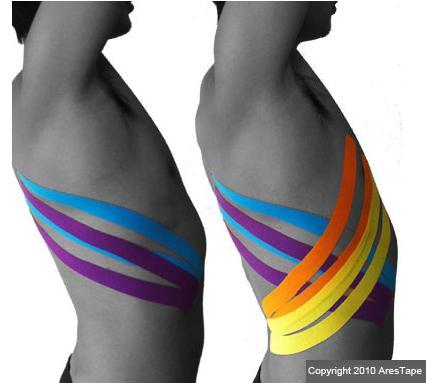
Intercostals’ neuralgia is a rare pain that involves the intercostals’ nerves that alimenting the muscles between the ribs. Patients with intercostals’ neuralgia experience bands of pain along the rib cage. The pain is commonly intermittent and spasmodic. The intensity of pain depends on different factors.
People can develop intercostals’ neuralgia after an injury that involved the nerves or as a consequence of a degenerative disease that pinches or otherwise damages the nerves. Typically, people experience pain while breathing, coughing, and laughing. They might feel pain during efforts too. Intercostals’ neuralgia can manifest as tingling, numbness, itchiness, or pain which can be felt at different moments. In some situations, the pain is intense and sharp, sometimes described as being “like a lightning bolt.”
Rheumatoid Arthritis (RA) : Elbow
You will need: 2 Y-Shaped kinesiotaping strips, and a partner for the application
Step 1 : Apply the base of the Y-shaped sport tape to the exterior part of the elbow, and stick the two wings on the triceps muscle while holding the hand on the back of the neck so that the elbow is bent.
Step 2 : Attach the other Y-shaped kinesiotape to the lateral side of the elbow sticking one wing toward the wrist and the other across the forearm.
Step 3 : No stretch is applied.
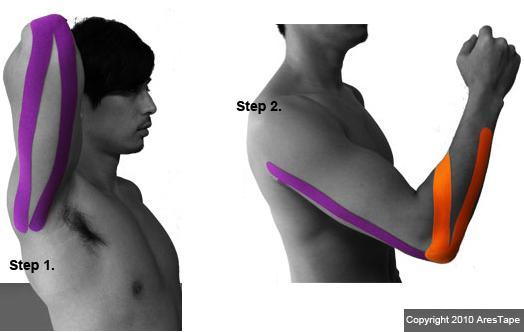
Rheumatoid Arthritis (RA) is a systemic disease that strikes several joints all around the body. About 90% of the people with rheumatoid arthritis eventually show symptoms linked to the foot or ankle. Normally, symptoms appear in the toes and forefeet first, afterwards it reaches the hind feet or the back of the feet, and at last the ankles.
The origins of RA are unknown, but there are various theories. Some people seem to be more likely to develop RA because of their genetic background. However, it normally needs a chemical or environmental ”trigger” to start the disease. In RA, the body’s immune system turns against itself. While it should protect the joints, the body produces instead a substance that strikes and inflames the joints possibly gut bacteria.
As RA affects your whole system, you may also have fever, feel tired easily, and lose your appetite. You can also develop lumps around your joints, particularly near the elbow.
Treatment
Exercise is essential in the treatment of RA. Your doctor or physical therapist can advise stretching as well as functional range of movement exercises.
Tennis Elbow – (Lateral Epicondylitis)
You will need: 2 Y-Shaped kinesiotaping strips, 1 I-shaped kinesiotaping strip.
Self taping possible
Step 1 : Apply the first Y-Shaped kinesiotape on the front part of the wrist and stick the wings all along the arm up until the elbow, while holding the wrist bending backwards.
Step 2 : Apply the other Y-Shaped kinesiotape on the medial side of the elbow, and stick the wings around the arm.
Step 3 : Attach the last piece of sport tape over the medical part of the elbow with a 50% stretch application.
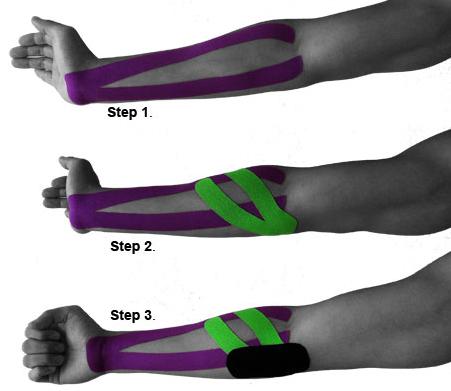
Tennis elbow, or lateral epicondylitis, is a condition of the elbow caused by overuse. As the nickname of this condition tells us, playing tennis or other racquet sports can be the origin of it. But practices of other activities may also increase the risk.
Tennis elbow is an inflammation of the tendons that link the forearm muscles on the outside of the elbow. The forearm muscles and tendons are damaged from overuse — by always repeating the same movements. This conducts to pain and tenderness on the outside of the elbow.
The symptoms of tennis elbow evolve gradually. In a major part of the cases, the pain starts as and gradually worsens overtime. There is normally no specific injury associated with the start of the signs.
Common symptoms of tennis elbow include:
* Pain or burning feeling on the outside of your elbow
* Weak grip strength
The symptoms are often deteriorating with forearm activity, such as holding a racquet, turning a wrench, or shaking hands. Your dominant arm is most likely affected; however both arms can be touched.
Approximately 80% to 95% of patients gain recovery with nonsurgical treatment
Golf Elbow – (Medial Epicondylitis)
You will need: 2 Y-Shaped kinesiotaping strips, 1 short I-shaped kinesiotaping strip, and 1 long I-Shaped kinesiotaping strip, and a partner for the application.
Step 1 : Apply the bases of each Y-Shaped sport tape on the elbow, sticking the wings over the whole upper arm and maintaining the hand on the other shoulder.
Step 2 : Stick the long piece of I-shaped kinesiotape on the lateral side of the elbow and apply it all around the forearm inwards as described on the figure, while bending a little bit the elbow.
Step 3 : Finally place the last piece of I-shaped soprt tape on the lateral side of the elbow with a 50% stretching application.

On top of the list of injuries is golfer’s elbow, and one of the best manners to avoid elbow troubles is to strengthen the forearm muscles and slow down the swing movement so that the shock in the arm when the ball is hit by the golfer will be less felt and harming, causing less damage.
To avoid golfer’s elbow, simple exercises can help build up your forearm muscles.
Squeezing a tennis ball
Squeezing a tennis ball for five minutes at a time is a mere but effective exercise that will strengthen your forearm muscles.
Wrist curls
Use a lightweight dumbbell. Decrease the weight at the end of your fingers, and then curl the weight back into the palm of your hand, followed by curling up your wrist to lift the weight an inch or two higher. Repeat it 10 times with each arm.
Reverse wrist curls
Use a lightweight dumbbell. Place your hands in front of you, with the palm facing down. Using you’re the wrist, lift the weight upwards and downwards. Hold the exercising arm above your elbow with your other hand in order to limit the motion to your forearm. Repeat it 10 times with each arm.
Rheumatoid Arthritis (RA) : Wrist
You will need: 1 long & 1 short Y-Shaped kinesiotaping strips.
Self Taping possible
Step 1 : Apply the base of the long Y sport tape on the outside of the elbow, sticking the two wings over the back of the hand, while holding this hand on the same side shoulder.
Step 2 : The short Y sport tape will be applied from the inner wrist outwards as described on the figure.
Step 3 : No stretch applied.
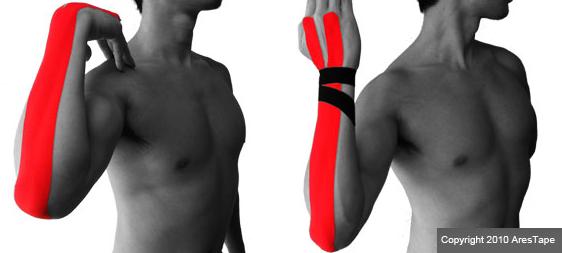
Rheumatoid Arthritis (RA) is a systemic disease that strikes several joints within all the body. Around 90% of the people with rheumatoid arthritis eventually show symptoms linked to the foot or ankle. Normally, symptoms appear in the toes and forefeet first, afterwards it reaches the hind feet or the back of the feet, and at last the ankles.
The origins of RA are unknown, but there are various theories. Some people seem to be more likely to develop RA because of their genetic background. However, it normally needs a chemical or environmental ”trigger” to start the disease. In RA, the body’s immune system turns against itself. While it should protect the joints, the body produces instead a substance that strikes and inflames the joints.
As RA affects your whole system, you may also have fever, feel tired easily, and lose your appetite. You can also develop lumps around your joints, particularly near the elbow.
Treatment
Exercise is very important in the treatment of RA. Your doctor or physical therapist may recommend stretching as well as functional and range of motion exercises.
Thumb Tendinitis – De Quervain’s Tendinitis (De Quervain’s Tendinosis)
You will need: 1 Y-shaped & 1 I-shaped kinesiotaping strips.
Self Taping is possible.
Step 1 : Apply the I-shaped sport tape from the tip of the thumb until the lateral side of the elbow while maintaining the wrist bending outward.
Step 2 : Apply the base of the Y-Shaped kinesiotape on the thumb side of the wrist, sticking one wing around the wrist, and the other one the forearm as demonstrated on the figure.
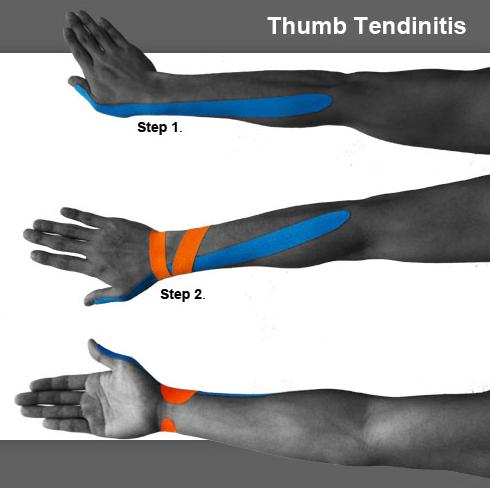
De Quervain’s tendinitis happens when the tendons around the bottom of the thumb are irritated or constricted. The word ”tendinitis” refers to a swelling of the tendons. The thickened tendons may be responsible for pain and tenderness along the thumb part of the wrist. This is particularly observable when forming a fist, grasping things, or when moving the wrist.
Symptoms of De Quervain’s tendinitis:
* Pain can be felt over the thumb side of the wrist. This is the major symptom. The pain may appear either gradually or suddenly. Pain is felt in the wrist and irradiate up the forearm. The pain is usually worse when the hand and thumb are used. This is particularly verified when grasping objects with strength or twisting the wrist.
* Swelling can be seen over the wrist’s thumb side. This swelling may occur together with a fluid-filled cyst in this region.
* A ”catch up” or ”snap” sensation might be experienced when moving the thumb.
* Pain and swelling can make it harder to move the thumb and wrist.
* Numbness can be felt on the backside of the thumb and index. This is due to the nerve lying on top of the tendon sheath which is irritated.
The purpose of treating de Quervain’s tendinitis is to relieve the pain caused by irritation and swelling.
Rheumatoid Arthritis (RA) : Finger
You will need: 2 pieces of I-Shaped kinesiotaping strips
Self taping possible
Step 1 : Stick the first strip of sport tape from the backside of the wrist until the tip of the finger while stretching the finger.
Step 2 : Stick the other strip of kinesiotape from the front side of the wrist to the tip of the finger while maintaining it stretched.
Step 3 : No Stretch applied.
Can be done for all fingers.
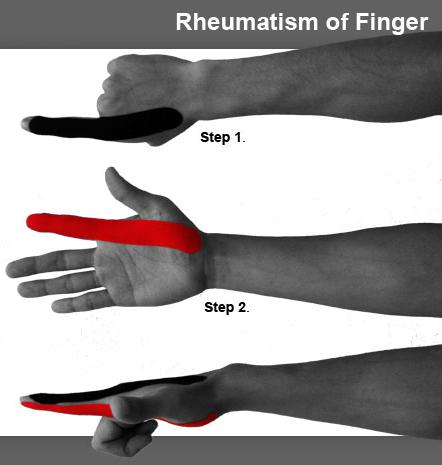
Rheumatoid Arthritis (RA) is a systemic disease that strikes several joints within all the body. Around 90% of the people with rheumatoid arthritis eventually show symptoms linked to the foot or ankle. Normally, symptoms appear in the toes and forefeet first, afterwards it reaches the hind feet or the back of the feet, and at last the ankles.
The origins of RA are unknown, but there are various theories. Some people seem to be more likely to develop RA because of their genetic background. However, it normally needs a chemical or environmental ”trigger” to start the disease. In RA, the body’s immune system turns against itself. While it should protect the joints, the body produces instead a substance that strikes and inflames the joints.
As RA affects your whole system, you may also have fever, feel tired easily, and lose your appetite. You can also develop lumps around your joints, particularly near the elbow.
Treatment
Exercise is very important in the treatment of RA. Your doctor or physical therapist may recommend stretching as well as functional and range of motion exercises.
Rheumatoid Arthritis (RA) : Knee
You will need: 2 pieces of Y-shaped kinesiotaping strips.
Step 1 : Apply the base of the Y-shaped kinesiotape on the medial side of the knee and stick both wings on the inner part while bending the knee a little bit.
Step 2 : Stick the other Y-shaped sport tape on the medial side of the knee, applying the tails around the knee cap.
Step 3 : No stretch applied.
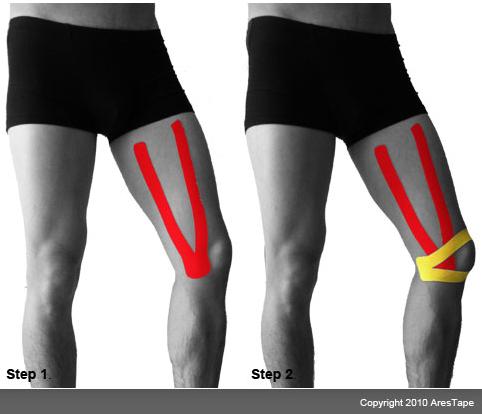
Rheumatoid Arthritis (RA) is a systemic disease that strikes several joints within all the body. Around 90% of the people with rheumatoid arthritis eventually show symptoms linked to the foot or ankle. Normally, symptoms appear in the toes and forefeet first, afterwards it reaches the hind feet or the back of the feet, and at last the ankles.
The origins of RA are unknown, but there are various theories. Some people seem to be more likely to develop RA because of their genetic background. However, it normally needs a chemical or environmental ”trigger” to start the disease. In RA, the body’s immune system turns against itself. While it should protect the joints, the body produces instead a substance that strikes and inflames the joints.
As RA affects your whole system, you may also have fever, feel tired easily, and lose your appetite. You can also develop lumps around your joints, particularly near the elbow.
Treatment
Exercise is very important in the treatment of RA. Your doctor or physical therapist may recommend stretching as well as functional and range of motion exercises.
Calf Swelling
You will need: Two pieces of Y-Shaped physio tape, and a partner for application
Step 1 : Apply the base of the first Y sport tape on the outside of Achilles tendon, and stick the wings up on the inner side of the knee while maintaining the foot pointing upward.
Step 2 : Apply the other base of Y sport tape on the inner side of the Achilles tendon while sticking the two wings on the outer side of the knee, along the calf, holding the foot pointing upward.
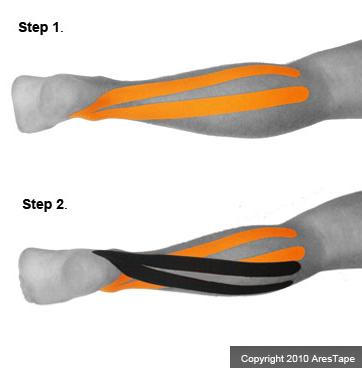
Injuries to the calf muscle because of the strain leads to swelling. Bruising might be present. Strain happens when the muscle fibres are torn. When the calf muscle is partially or totally torn, bruising swelling and pain are present. Break can sometimes be obvious if the muscle ”balls up” in the upper part of the calf.
Rheumatoid Arthritis (RA) Ankle
You will need: 3 I-shaped kinesiotaping strips.
Self taping possible
Step 1 : Apply the first I physio tape on the side of the knee cap towards the upper part of the foot, while holding the ankle lifted.
Step 2 : Apply the other sport tape on the same spot towards the outside part of the foot.
Step 3 : Stick the last strip of kinesiotape across the sole with one end on the medial ankle and the other one on the lateral side of the ankle.
Step 4 : No stretch applied.
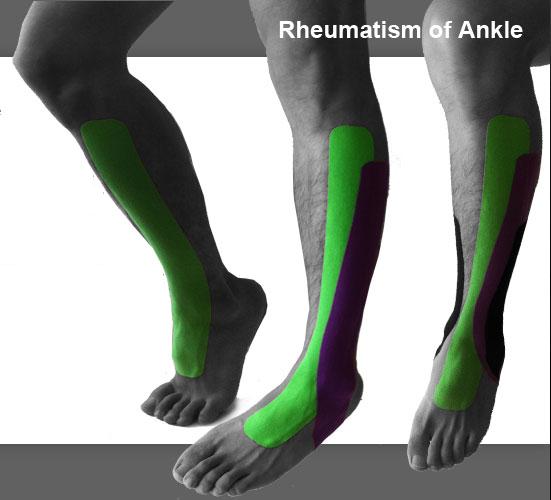
Rheumatoid Arthritis (RA) is a systemic disease that attacks multiple joints throughout the body. About 90% of the people with rheumatoid arthritis eventually develop symptoms related to the foot or ankle. Usually, symptoms appear in the toes and forefeet first, then in the hind feet or the back of the feet, and finally in the ankles.
The exact cause of RA is unknown, but there are several theories. Some people may be more likely to develop RA because of their genes. However, it usually takes a chemical or environmental ”trigger” to activate the disease. In RA, the body’s immune system turns against itself. Instead of protecting the joints, the body produces substances that attack and inflame the joints.
Because RA affects your entire system, you may also feel feverish, tire easily, and lose your appetite. You may develop lumps around your joints, particularly by the elbow.
Treatment
Exercise is very important in the treatment of RA. Your doctor or physical therapist may recommend stretching as well as functional and range of motion exercises.
Muscle Cramp (Calf Cramp)
You will need: 2 short Y-shaped, 1 long Y-shaped, 1 I-Shaped kinesiotaping strips and a partner for application.
Step 1 : Apply the two small Y-Shaped sport tapes on the base of the foot (Sole) as shown on the figure while lying on the front side of the body, with the knees bending, and toes stretched out.
Step 2 : Apply the base of the long Y-Shaped sport tape on the heel, and stick the two wings on each side of the calf up until the knee.
Step 3 : Apply the last I-Shaped kinesiotape on the heel until the back of the knee, covering the calf.
Step 4 : No stretch applied
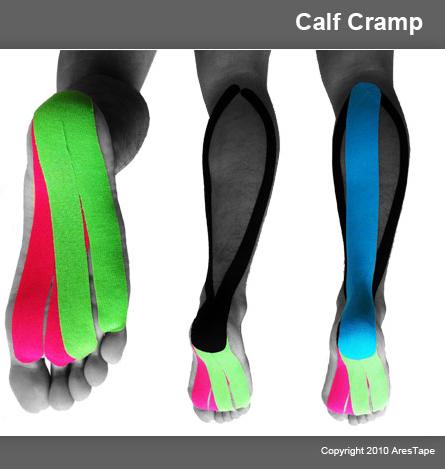
A cramp is a non voluntary and forced contracted muscle that does not rest. Any muscle under your voluntary control (skeletal muscle) can suffer from cramps. Muscles that cover two joints are most likely to be affected by a cramp. Cramps can affect a part of or the entire muscle, or even several muscles in a group.
The most commonly affected muscle groups are:
* Back of lower leg/calf (gastrocnemius)
* Back of thigh (hamstrings)
* Front of thigh (quadriceps)
Cramps in other parts of the body such as the feet, hands, arms, abdomen, and along the rib cage are very usual too.
Although the exact origins of muscle cramps is not known (idiopathic), some researchers think inadequate stretching and tired muscle leads to abnormalities in mechanisms that control muscle contraction. Other reasons might also be explaining cramps, like poor conditioning, exercising or working in intense heat, dehydration and lack of salt and minerals (electrolytes).
Treatment
Cramps usually go away on their own without seeing a doctor.
* Stop doing the activity that triggered the cramp.
* Gently stretch and massage the cramping muscle, holding it in stretched position until the cramp stops.
* Apply heat to tense/tight muscles, or cold to sore/tender muscles.
Prevention
To avoid cramps, try to ameliorate your overall fitness. Repeat flexibility exercises before and after you work out to stretch muscle groups most prone to cramping.
Flat Foot
You will need: 2 small Y-shaped kinesiotaping strips
1 I-shaped kinesiotaping strip
Self taping possible
Step 1 : Apply the two Y-shaped sport tapes on the heel until the toes while stretching them.
Step 2 : Place the I-shaped kinesiotape from the lateral side of the smallest toe, to the inside part of the ankle with a slight stretch.
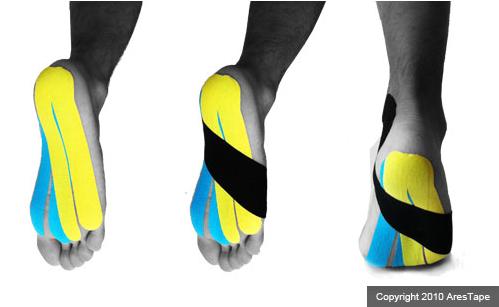
Flat foot is when the longitudinal arch or instep of the foot collapses ending up touching the ground. In infants and young children, the longitudinal arch is not developed and flat feet are a normal condition. In some people though, the longitudinal arch never actually develops.
Flat feet may be related with pronation, a bending inward of the ankle bones toward the middle line.
Some very usual signs of a flat foot are:
* A flat look to one foot or two
* Uneven shoe tear and collapse of your shoe toward the inside of your flat foot
* The lower leg is painful
* Pain felt on the inside part of your ankle
* Swelling along the inside part of your ankle
* Foot pain
Sourced through Scoop.it from: circleofdocs.com
By Dr. Alex Jimenez
Kinesiotape is a wonderful product that is the equivalent of duct tape. It works for everything where the body is involved. From injury prevention to injuries themselves, these are various tape jobs that not only doctors, but everyone should know about.
Post Disclaimer
Professional Scope of Practice *
The information on this blog site is not intended to replace a one-on-one relationship with a qualified healthcare professional or licensed physician and is not medical advice. We encourage you to make healthcare decisions based on your research and partnership with a qualified healthcare professional.
Blog Information & Scope Discussions
Welcome to El Paso's Premier Wellness and Injury Care Clinic & Wellness Blog, where Dr. Alex Jimenez, DC, FNP-C, a board-certified Family Practice Nurse Practitioner (FNP-BC) and Chiropractor (DC), presents insights on how our team is dedicated to holistic healing and personalized care. Our practice aligns with evidence-based treatment protocols inspired by integrative medicine principles, similar to those found on this site and our family practice-based chiromed.com site, focusing on restoring health naturally for patients of all ages.
Our areas of chiropractic practice include Wellness & Nutrition, Chronic Pain, Personal Injury, Auto Accident Care, Work Injuries, Back Injury, Low Back Pain, Neck Pain, Migraine Headaches, Sports Injuries, Severe Sciatica, Scoliosis, Complex Herniated Discs, Fibromyalgia, Chronic Pain, Complex Injuries, Stress Management, Functional Medicine Treatments, and in-scope care protocols.
Our information scope is limited to chiropractic, musculoskeletal, physical medicine, wellness, contributing etiological viscerosomatic disturbances within clinical presentations, associated somato-visceral reflex clinical dynamics, subluxation complexes, sensitive health issues, and functional medicine articles, topics, and discussions.
We provide and present clinical collaboration with specialists from various disciplines. Each specialist is governed by their professional scope of practice and their jurisdiction of licensure. We use functional health & wellness protocols to treat and support care for the injuries or disorders of the musculoskeletal system.
Our videos, posts, topics, subjects, and insights cover clinical matters and issues that relate to and directly or indirectly support our clinical scope of practice.*
Our office has made a reasonable effort to provide supportive citations and has identified relevant research studies that support our posts. We provide copies of supporting research studies available to regulatory boards and the public upon request.
We understand that we cover matters that require an additional explanation of how they may assist in a particular care plan or treatment protocol; therefore, to discuss the subject matter above further, please feel free to ask Dr. Alex Jimenez, DC, APRN, FNP-BC, or contact us at 915-850-0900.
We are here to help you and your family.
Blessings
Dr. Alex Jimenez DC, MSACP, APRN, FNP-BC*, CCST, IFMCP, CFMP, ATN
email: coach@elpasofunctionalmedicine.com
Licensed as a Doctor of Chiropractic (DC) in Texas & New Mexico*
Texas DC License # TX5807
New Mexico DC License # NM-DC2182
Licensed as a Registered Nurse (RN*) in Texas & Multistate
Texas RN License # 1191402
ANCC FNP-BC: Board Certified Nurse Practitioner*
Compact Status: Multi-State License: Authorized to Practice in 40 States*
Graduate with Honors: ICHS: MSN-FNP (Family Nurse Practitioner Program)
Degree Granted. Master's in Family Practice MSN Diploma (Cum Laude)
Dr. Alex Jimenez, DC, APRN, FNP-BC*, CFMP, IFMCP, ATN, CCST
My Digital Business Card


